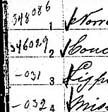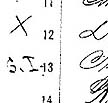Numbers, often in consecutive order |
 |
|
Numbers like those above are occasionally found in the left margin, especially on lists
of ships from England. The numbers can have as few as 2 or 3 digits, and as many as 6 or 7
digits. These are "contract ticket" numbers issued by the steamship companies when contracting
with the immigrant for their passage. The number may or may not have appeared on the immigrant's
actual ticket or receipt. The steamship lines used the number as a personal identifier, and
recording the number allowed the companies to match the manifest record with other business records.
The numbers bear no relation to any other United States records. However, they may be useful in
matching a U.S. passenger arrival record with a British departure record (British "outbound lists").
Lists from the 1890's or even the very early 1900's may have been printed by the steamship line
with a "Contract Ticket" number column. This has been seen on passenger lists of the American
Line from England in the mid-1890's. The presence of such a column demonstrates the importance
of the information to the steamship company, and helps explain why it might be annotated at left
on a list without a "Contract Ticket" column.
In some rare cases, typically on earlier lists prior to addition of the "Head Tax" column, a
solitary number will appear to the left of a passenger's name. These lonely numbers are usually
Head Tax receipt numbers. Notation of the receipt number may indicate either that the immigrant
requested a receipt, disputed his/her requirement to pay the tax, or was only passing through the
U.S. in transit (in which case the Head Tax deposit would be refunded upon their departure).
|
"Not Shipped," N.O.B., or "Did Not Sail" |
 |
|
Often passengers booked to sail on a given ship did not depart. Perhaps they missed the ship,
or changed their travel plans, or became ill and health officials prevented them from boarding
the ship. Whatever the case, in some instances the change or decision occurred so late there
was no time to amend the passenger list. Their names and passenger information remain on lists
for ships upon which they never arrived.
To indicate the record is meaningless, steamship company employees would mark the record in one
of several ways. The most common was to "line out" the entire record with dark grease pencil or
ink. Some of the lines are straight across and can be difficult to differentiate from scratches
on the microfilm. Others are deliberately "wavy."
Some records remain without a line, but are noted in the left margin as "N.O.B." (Not On Board),
"did not sail," or, like the stamp above, "Not Shipped." It was important for the steamship company
to make clear who was and was not on board the ship when it arrived in the United States. The
company was responsible for paying the Head Tax on each immigrant landed, and government officials
calculated the company's monthly bill using the manifest lists. The passenger booked below "cancelled."
Note well that some of those names "lined out" were on board, but are officially recorded
on another page of the passenger list. The example below includes two crossed-off names because
they were "Not on Board," but one name is lined-out (line 21) because he/she is a "2nd class passenger."
The official record of that person is, then, on the list of second class passengers.
|
Letters (including "X," "D," "S.I.," "B.S.I.,") or the word "Held"
|
 |
|
Extremely common are letters and stamps in the left margin relating to an immigrant's detention
or their being held for a Board of Special Inquiry hearing. The general rule is that some
notation was made at left to indicate the immigrant was held for some reason. One cannot
determine the reason by looking at the annotation, and unless it was subsequently stamped
"Admitted" or "Deported," one cannot determine the outcome.
|
|
In practice, variation can be found between the records of different ports. For example, the
annotation "D" on a New York list means the immigrant was temporarily detained. But on a
Philadelphia list, "D" can indicate either that the immigrant was temporarily detained or that
he/she was held for a Board of Special Inquiry. The letters "X," "D," and the word "Held" can
mean either that the immigrant went to temporary detention or had a Special Inquiry hearing.
The more specific "S.I." and "B.S.I." indicate the immigrant was held for a hearing.
|
 |
|
Unfortunately, for many passenger lists there is no additional information on the immigrant's fate.
To date, additional records are known to survive for only two ports, and only for certain years.
These ports are New York and Philadelphia.
Beginning in 1903, the Immigration Service at New York began filing Records
of Detained Aliens and Records of Aliens Held for Special Inquiry at the
end of each passenger list. Whenever a researcher finds an annotation in the left margin suggesting
the immigrant was detained or held for a hearing, he or she should turn to the end of the passenger
list and check these appended records to see if they contain further information.
Philadelphia records of detained immigrants (including those held for hearings) are extensive.
They date from 1882 but only extend to ca. 1909. Some, dating from 1893 to 1909, are on microfilm
as National Archives publication M1500. The majority remain in hard copy at the Regional Archives
in Philadelphia. Anyone finding a detention annotation on a Philadelphia passenger list from this
era should seriously consider investigating the Philadelphia detention records. And for Jewish
immigrants, they might also consider the HIAS records in the Jewish Archives at Philadelphia's Balch
Institute for Ethnic Studies.
|
 Markings on the Manifest's Left Margin
Markings on the Manifest's Left Margin




